

Custom Search
|
|

|
||
 MIL-HDBK-419A
10.3.1 Current in Long Lines.
10.3.1.1 Long Overhead Lines.
The currents induced on long straight overhead lines parallel to the Earth's surface by HEMP-like events have
been analyzed thoroughly (10-4), (10-5), (10-6). If the line is over a perfectly conducting ground plane, the
current has a waveform similar to the HEMP early-time waveform, except for a slightly longer risetime for
lines more than a few feet high. For imperfectly conducting ground, such as soil, the imperfect reflection of
the wave from the ground allows the line to be driven more strongly and for a longer time than if the ground
were a good conductor.
The short-circuit current induced in a semi-infinite line (one extending from the observer to infinity) over soil
for an exponential pulse of incident field is shown in Figure 10-4.
The current is shown for horizontal
polarization (dashed line) and vertical polarization (solid line) of the incident field. The curve
is the
current that would be induced in a wire over a perfectly conducting ground; this current is proportional to line
height (h), decay time constant
and incident field strength
The current in Figure 10-4 is normalized by
containing the characteristic impedance of the line, the peak field
and decay time constant
of the
incident field, the speed of light (c), and a directivity function (D). The directivity function (D) depends on the
azimuth angle
between the wire and the vertical plane containing the Poynting vector of the incident wave,
and on the elevation angle
of the ?oynting vector of the incident wave. The correction for finitely
conducting ground is proportional to the incident field strength, the 3/2 power of the decay time constant, and
the inverse square root of the soil conductivity (a).
For a
line 10 meters (33 feet) above soil having
siemans/meter (S/m) conductivity, an incident 15
kV/m exponential pulse with 250 nanoseconds (ns) decay time-constant will induce a short-circuit current of
about 10kA on the line. Vertically polarized waves induce larger currents than horizontally polarized waves,
but in the latitudes of the mainland United States, the HEMP fields are predominantly horizontally polarized.
Thus, only 15 kV/m was used in this example, even though the peak HEMP field may be much larger than 15
kV/m. More sophisticated analyses that take into account the burst point, the observer point, and their effect
on HEMP polarization and waveform give peak short-circuit currents between 5 and 10 kA for the early-time
HEMP. The open-circuit voltage induced at the end of the semi-infinite line is the product of the short-circuit
current and the characteristic impedance
For the
line in this example, the open-circuit voltage
would be 3 megavolts (MV).
10-6
|
 |
|
 |
||